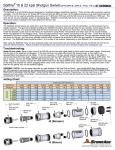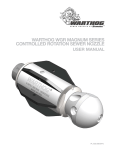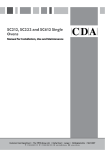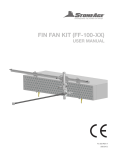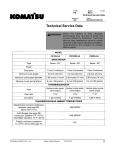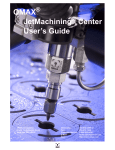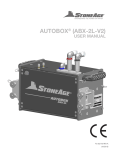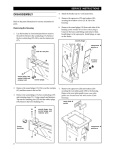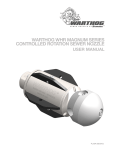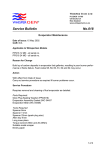Download User Manual
Transcript
Badger TM 4" 40K Self-Rotary Swivel (BA-H6) US Patent No. 5,964,414 & 6,059,202 Description: The Badger™ Rotary Waterblast Nozzle was designed for waterblast cleaning of pipes as small as 4 inch with elbows. The BA-H6 has a 3/8 high pressure female inlet connection and a maximum operating pressure of 40,000 psi (2800 bar). A viscous fluid is used to control rotation speed in the range of 200 to 500 rpm. The Badger™ heads have S6 ports; one at 15 degrees, two at 100 degrees, and two at 125 degrees. Engraved on each head is R14 or R24; this number is the offset of the head that makes it rotate. The flow range for each head is given in the table; nozzle sizes must be selected to fit within this flow range. If the flow is less than the range shown, the tool will not rotate; if it is more than the allowable the tool will rotate too fast and wear out the seals and bearings. Flow Range Press. psi R24 R14 4.7-11 gpm 9.5-16 gpm 40,000 (2800 bar) Operation: The first step is to determine the jet sizes. Jet thrust is used to pull the tool through the pipe. An estimate of the amount of pulling force required is useful and depends on the number of elbows and any vertical climbs that must be made. On a horizontal run with no elbows, 1 pound of pull is required for every ten feet. When climbing vertically, the pulling force must equal the weight of the tool and the hose. Typically, larger jet sizes using 50 to 80 percent of the total flow are used in the back ports. As little as 10 percent of the total flow is given to the front jet, because it pushes the wrong direction and is only used to open up blockages. The remaining flow goes to the 100 degree ports, which do help pull as well. Nozzles selected should be matched pairs, except the front jet. When installing nozzles, we recommend using Blue Goop anti-sieze. Because of the short length of the Badger, the tool turn can around in large pipes and come back at the operator at a high rate of speed. If cleaning larger pipes, a rigid "stinger" should be used between the hose and the tool. It is recommended that the rigid length of the tool including hose end is one and a half times the inside diameter of the pipe being cleaned. Make sure there is an operator controlled dump in the system, operated by the person closest to the cleaning job. Flush out the high pressure hoses before connecting the Badger. It is recommended that the hose be marked a few feet from the end with a piece of tape so the operator knows when to stop on the way back out. Position the tool in the pipe opening. Close the dump and slowly bring up to pressure the first time to make sure no nozzles are plugged and the jet thrust is correct. The Badger should begin to slowly rotate. Once operating pressure is reached, feed the tool into the pipe to begin the cleaning job. Allow the jets time to do their work by feeding the hose out at a controlled rate. When the work is complete and the tool is disconnected from the hose, blow out all water to prolong the life of the tool. A small amount of oil can be blown into the tool as well. 1-1/2 times pipe ID rigid "stinger" IMPROPER USE: Badger will turn around in large diameter pipe VERY DANGEROUS! PROPER USE: Badger with rigid "stinger" to prevent turnaround, still able to pass thru elbows High-pressure seal leak: The high pressure seal may leak initially at lower pressures, but should pop closed as pressure is increased. A continuous leak at operating pressure from the weep holes indicates the need to replace the HP Seal and Seat. HP Seals wearing out too quickly can be an indication that the HP Seat is installed upside-down, or the tool is over spinning. Over spinning is caused by low or contaminated viscous fluid, water in the fluid chamber (replace shaft seals), or too much jet torque. Refilling the viscous fluid every 30-40 hours of operation is important for proper speed control. Only use StoneAge recommended viscous fluid. Tool will not rotate: Check the nozzles for plugging or wear (nozzles have to be removed to check for obstructions), Check that the nozzle sizes are correct for the desired flow and that the desired flow matches the head flow range. Check that the nozzle sizes are installed in a balanced configuration. If the tool feels rough when manually rotating the head, this indicates internal damage. Replace bearings, shaft seals, viscous fluid, and O-Rings. Maintenance: For H.P. Seal Replacement see Assembly Instructions The most important item in maintaining the Badger™ is keeping the tool full of viscous fluid, which controls the rotation speed. As the viscous fluid is lost or contaminated, the rotation speed of the tool will increase, which shortens the high pressure seal and bearing life. To fill the Badger™ with viscous fluid: 1. Unscrew the head from the nut. 2. Remove the Port Screws (BJ 026) in the Nut and Seal Holder. 3. Fill the Syringe (BC 410) with viscous fluid by removing the end near the handle, pulling out the plunger, and pouring the viscous fluid in from the back end. 4. Thread the syringe end into the port in the Nut, and squeeze fresh viscous fluid in until clean viscous fluid comes out the port in the Seal Holder. Hold the tool so the port in the Seal Holder is the highest point. 5. Remove the Syringe and install the Port Screws. 6. Reinstall the Head into the Nut and tighten to 40 ft-lb. BJ 026 Port Screw (in Seal Holder) Available Maintenance Kits: BA 600-H6 BA 602-H6 BA 610-H6 BA 612-H6 Service Kit (Includes items needed for maintenance) Seal Kit (Includes parts needed for one seal change) Overhaul Kit (Includes parts needed for tool rebuild) Tool Kit (Includes tools to aid assembly) BC 410 Syringe spring side towards shaft spring side towards shaft BA 602-H6 Seal Assy BA 422 Inlet Seat BA 007 Shaft Seal BA 002 Nut BJ 026 Port Screw (in Nut) BC 040 O-Ring OS-6 XXX (5) Sapphire Nozzle SC 212 007 (2) Bearing BA 401 Inlet Shaft EZ 029 Shaft Seal BA 408 O-Ring BA 406 Seal Holder BJ 026 (2) Port Screw BC 506 Seat Face BC 520 Seal Retainer © 2010 StoneAge®, All Rights Reserved BC 524 Compression Spring BC 512-O H.P. Seal BC 511 Carbide Seat WG 008 O-Ring BA 030 Wear Ring BA 440-RXX Head Badger TM 4" 40K Self-Rotary Swivel (BA-H6) US Patent No. 5,964,414 & 6,059,202 Disassembly: 1. Unscrew the Head (BA 440) from the Nut (BA 002). 4. Unscrew the Seal Holder (BA 406) from the Nut (BA 002). 7. Remove the Shaft Seal (EZ 029) from the Seal Holder if it is damaged. 5. Remove the Shaft Seal (BA 007) from the Nut if it is damaged. 2. Pull the Seal Assy (BA 400) out BA 406 of the Seal Holder (BA 406). Seal Holder 8. Remove the O-Ring (BA 408) from the Seal Holder if it is damaged. 6. Remove the Port Screw (BJ 026) from the Nut. 3. Remove the O-Ring (WG 008) from the Head if it is damaged. 9. Remove the Port Screw (BJ 026) from the Seal Holder. BA 007 Shaft Seal BA 440 Head BA 408 O-Ring EZ 029 Shaft Seal BA 401 Inlet Shaft BA 002 Nut BA 002 Nut WG 008 O-Ring BA 030 Wear Ring BA 406 Seal Holder BJ 026 Port Screw BJ 026 Port Screw BA 602-H6 Seal Assy BA 401 Inlet Shaft BA 406 Seal Holder 10. Press the Bearings (SC212 007) off of the Inlet Shaft. BA 002 Nut SC 212 007 Bearing Assembly: 2. Press the Shaft Seal (EZ 029) into the Seal Holder with the spring side visible. BA 401 Inlet Shaft 3. Press the O-Ring (BA 408) into the groove on the Seal Holder. 1. Press the Bearings (SC212 007) onto the Inlet Shaft. BA 408 O-Ring SC 212 007 Bearing EZ 029 Shaft Seal spring side BA 406 Seal Holder BJ 026 Port Screw BJ 026 Port Screw 6. Fill the Assembly with viscous fluid as described in the maintenance section and install the Port Screws. 4. Press the Shaft Seal (BA 007) into the Nut with the spring side visible. BA 007 Shaft Seal BA 002 Nut BJ 026 Port Screw BJ 026 Port Screw 5. Apply grease to the Seal lips in the Seal Holder and the Nut; Slide the Inlet Shaft with Bearings into the Seal Holder (BA 406); apply antisieze to the threads and screw the Seal holder into the Nut (BA 002), taking care not to damage the Seals. Torque to 25 ft-lbs. BA 406 Seal Holder BA 401 Inlet Shaft BA 002 Nut 7. Insert the BA 602-H6 Seal Assy components into the Seal Holder as shown below: First, install the Seat Face (BC 506). Second, install the Seal Retainer (BC 520). Third, install the Carbide Seat (BC 511) into the Seal Retainer with the chamfered end up. Fourth, install the Compression Spring (BC 524) and the H.P. Seal (BC 512-O) into the Inlet Seat (BA 422) and then insert the Inlet Seat into the Seal Holder; note the orientation and relationship of H.P. Seal and Carbide Seat. Finally, install the O-Ring (BC 040) into the top of the Inlet Seat. BC 040 O-Ring BC 512-O H.P. Seal 8. Install O-Ring (WG 008) over threads and into groove on Head. 9. Apply anti-seize to threads on Head; install Wear Ring (BA 030) onto the Nut (BA 002); thread the Head into the Nut. Tighten to 40 ft-lb. BA 422 Inlet Seat BC 524 Compression Spring BA 406 Seal Holder WG 008 O-Ring BC 512-O H.P. Seal BC 511 Carbide Seat BC 520 Seal Retainer BC 506 Seat Face BA 602-H6 Seal Assy © 2010 StoneAge®, All Rights Reserved chamfer BC 511 Carbide Seat Seal & Seat Detail BA 030 Wear Ring


